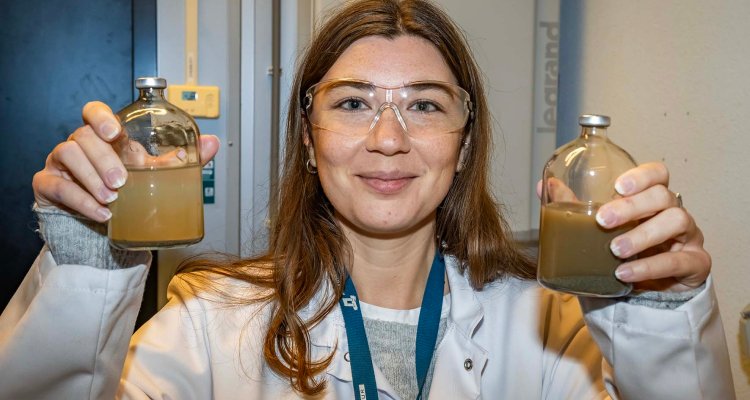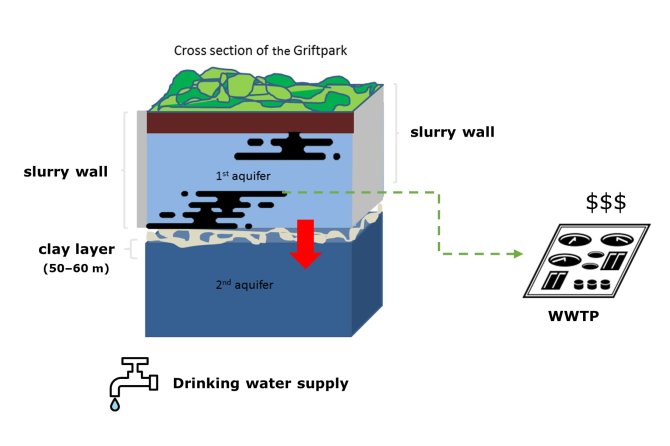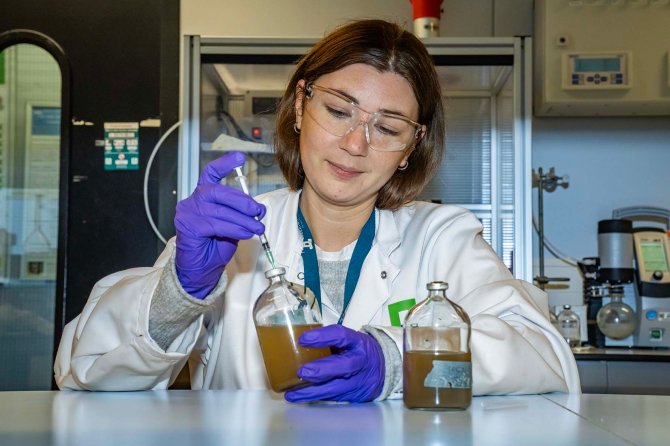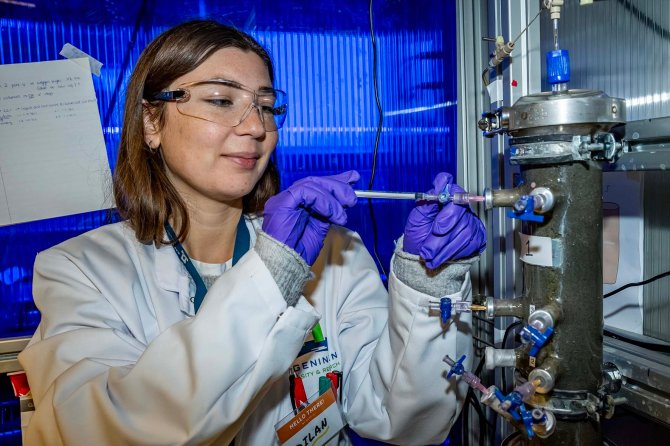
News
Science: Cleaning oil-contaminated soil using bacteria and a bit of oxygen
Using microorganisms and a smart design, PhD researcher Dilan Aydin, developed a method to effectively clean soil, contaminated with oil-derived hydrocarbons, like benzene, toluene, ethylbenzene and xylene (BTEX). Aydin: ‘We have shown that by creating a so-called micro-aerobic environment, where a little bit of oxygen is present, microorganisms can effectively clean hydrocarbon-contaminated soil.’
The Griftpark in Utrecht city is a popular recreation place, but 150 years ago, the green oasis looked completely different. For almost a century, a huge factory extracted gas from coal, that was used for lighting and heating. This process releases a cocktail of chemicals, including hydrocarbons, like BTEX. These waste chemicals were discharged into the soil or water. As a result, the soil under the Griftpark still is contaminated with these compounds. During the 1950’s, the plant was closed and in the 1990s, a first step to clean the contaminated soil was taken: the area was sealed by applying 30-meter-deep slurry walls around the site and the top soil was cleaned using microorganisms. Currently, contaminated ground water is continuously pumped to the wastewater treatment plant, four kilometers away. A yearly cost of 300.000 euro. ‘The cleaning of Griftpark was one of the largest and most expensive cleaning operations in The Netherlands’, Aydin says. ‘And despite the efforts, the deeper soils are still highly contaminated.’ This poses a serious risk to the deeper layer of ground water, since the contaminants are quite mobile and may easily seep from the first, contaminated aquifer through the porous clay layer and reach the deeper second aquifer, that is used for drinking water (fig. 1). Utrecht municipality was looking for a more permanent solution and decided to fund a large cleaning operation, where different institutions, like Deltares and the University of Utrecht collaborate in project BestParc. ETE contributes with developing methods to enhance the microbial degradation of the contamination.

Make bacteria happy
‘The soil and groundwater pollution in Griftpark is slowly degraded by the microorganisms present’, Aydin says. Especially in the top layers, oxygen is present and this helps the microorganisms to metabolize and breakdown the chemicals quicker.’ But in the deeper soil layers, conditions are virtually anaerobic: no oxygen is present and the microorganisms use other compounds, like nitrate (NO3-), sulfate (SO42-) and iron (Fe3+) to replace oxygen. But these are less efficient to help in the bacteria’s metabolism, resulting in a very slow breakdown. Therefore, a substantial risk that these chemicals spread to deeper layers exists. ‘To stimulate and speed up contaminant breakdown, my research focuses on how to make the bacteria happy, so they work more’, Aydin says with a smile. ‘So, we designed several lab experiments to find out how we could achieve that. The goal was not only to find a solution for Griftpark, but also to develop a proof of principle that optimized soil and groundwater contaminant degradation.’

Additional challenge
An important part of the experiments involved aerobic batch experiments, where small bottles were filled with clean sediments and ground water from Griftpark, to guarantee that bacteria that were naturally present were studied. By subsequently adding known amounts of different contaminants, the experiment was highly controlled and reproducible. ‘So, we used different contamination scenario’s’ Aydin says. ‘We investigated the breakdown of full mixtures, but we also studied the degradation of different combinations as well as single contaminants, like BTEX, but also tar oil components like indene, indane and naphthalene.’ Aeration of the bottles provided an aerobic (oxygen-rich) environment, optimizing breakdown conditions. The results of this first experiment were promising and informative: all contaminants were eventually completely degraded. However, when a limited number of compounds was supplied to the microorganisms, contaminant breakdown was almost three times quicker as compared to the full mixture, as found in Griftpark. Aydin: ‘The complex mixture of contaminants present in the soil of Griftpark clearly poses limitations on the breakdown. The bacteria are kind of ‘overwhelmed’ and can’t handle the large variety of compounds that well. In addition, the absence of oxygen in the deeper soil poses an additional challenge for the bacteria to quickly break down the contaminants present.’
Different set-ups
To further test the influence of different aerobic and anaerobic conditions on contaminant breakdown, Aydin experimented with different set-ups. Anaerobic conditions, where nitrate and/or sulfate were added to replace oxygen, revealed a much slower and incomplete degradation. When Aydin performed her degradation experiments under low-oxygen (microaerobic) conditions followed by anaerobic conditions, contaminant breakdown stopped as soon as the oxygen was depleted. ‘When we reversed this experiment and started with pre-anaerobic condition, and supplemented nitrate, there was no contaminant degradation until we added low-oxygen concentrations. This led to a more efficient breakdown than in experiment without the pre-anaerobic step.’ According to Aydin, this can be explained by the breakdown of organic matter during the pre-anaerobic step, whereafter, the supplemented oxygen could be exclusively used by the microorganisms to degrade the contaminants present.

Proof of principle
The results of batch experiments were confirmed in columns experiments, where a continuous flow made a more realistic, experimental environment. Aydin’s studies have resulted in a proof of principle to remediate contaminated soil. ‘Injecting low levels of oxygen using microbubbles in a contaminated site may help a rapid contaminant mixture breakdown’, Aydin say. ‘However, this should be preceded by adding nitrate and sulfate, to allow the breakdown of organic matter first, resulting a more effective use of oxygen during the breakdown of chemicals.’
Selected publication
Indene, indane and naphthalene in a mixture with BTEX affect aerobic compound biodegradation kinetics and indigenous microbial community development. Aydin, D.C., Faber, S.C., Attiani, V., Eskes, J., Aldas-Vargas, A., Grotenhuis T., and Rijnaarts H. 2023. Chemosphere, 340, 139761.https://www.sciencedirect.com/science/article/pii/S0045653523020283